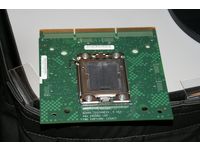IDF: Core i7 'Nehalem' Briefing Report
Intel gave a briefing today on what the public should expect to see in its upcoming Core i7 processors and the X58 chipset coming with it.
Stephen Thomas from Intel’s Platform Applications Engineering division gave a complete overview of the Core i7 processors as well as the specifications for the X58 chipset. The Core i7 will change several things over the Core 2 processors, including an integrated memory controller as well as the new Intel QuickPath Interconnect, which will eliminate the Front Side Bus (FSB). Beyond that, we can expect the first wave of i7 Processors to come with 12 MB of unified L3 cache, and also have the OverSpeed Protection removed, good news for all you overclockers out there.
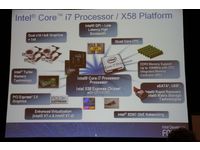

Another bonus coming with the new Nehalem architecture is how the processor will handle heat. With current processors, if a given heat is reached, the processor will automatically go to its lowest available frequency. While the processors will also lower the frequency, it will not automatically go down to the lowest possible point, instead utilizing a step process, going down one small step at a time until a desirable temperature is reached.
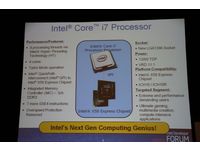
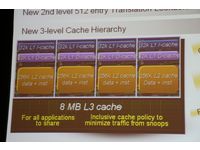
One of the most innovative features being found in the new Nehalem chips is the Turbo Mode, which will automatically overclock one or two cores in given situations. If only two of four available cores are needed, Turbo mode will kick in, shutting down the two unused cores as well as boosting the frequency of the other cores (add one performance bin to each). If only one core is needed, three will shut down and the frequency of the one active core will be boosted even more two performance bins).
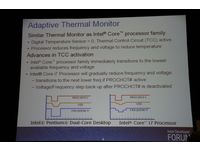
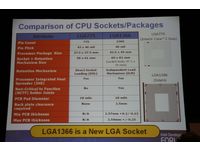
The biggest change we will see with the new processors and chipset is a new socket, LGA1366. Because of the increased size and thus increased tension, Intel is changing how the processor attaches to the motherboard by separating the retention mechanism from the board. Instead of being soldered to the board, the retention mechanism will screw into the board after the manufacturer or enthusiast places the processor into the bracket. Also, because everything is bigger, you’ll need a new heatsink or cooling solution, so if you plan on investing in a new i7/X58 setup, be prepared to buy a new aftermarket heatsink or liquid cooling system.
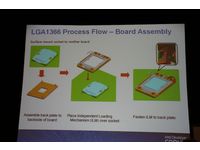
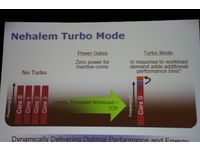
The new X58 chipset will bring a lot of welcome additions and changes, including three memory channels, which will allow for up to 24 GB of DDR3 memory. The new chipset will also use ICH10, so look for the expected eSATA as well as 12 USB ports.

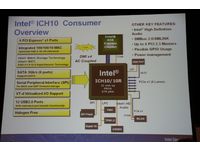
As far as discrete graphics support is concerned, you should expect what is already available – two x16 or four x8. It’s also noteworthy that the new ICH10 will be Halogen free, making the new chipset a little more environmentally friendly. Also look for the inclusion of Intel Turbo Memory, allowing for up to 4GB of memory to be attached, which should help with performance across a wide array of applications.
Get Tom's Hardware's best news and in-depth reviews, straight to your inbox.

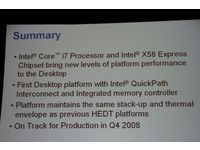
Stay tuned for more in-depth reports of Nehalem, as we’re only scratching the surface.
-
giovanni86 I am a litte over joyed by this incredible progress intel has been making with the Nehalem. Now i just hope larrabee dies.Reply -
rockyjohn And Intel doles out the news a little at a time, making publications their lackey for repeated marketing communications (newsvertisements). And I will march to their tune too as I try to slank my thirst for real information about the next big change in desktops.Reply -
elbert Now turbo mode is making sense with it only being able to do 1 bin higher in dual core or 2 bins higher in single core mode. I was afraid Intel was thoughing out their whole GHz pricing scale.Reply -
Turas It is interesting that they say LGA1366 is the new socket. I thought there were going to be two new sockets?Reply -
jaragon13 TurasIt is interesting that they say LGA1366 is the new socket. I thought there were going to be two new sockets?As far as I know,there is going to be a high end server socket,desktop socket(LGA1336),and a laptop socket.Pretty much like it's been with Intel's current CPU sockets.Reply -
Nothing in the way of these new features really indicates revolutionary performance, last time I read a benchmark article on here about Nehalem, it was 10% faster than Conroe(although when Penryn came out it was also 10% faster than Conroe....), and there was pretty much a refusal to compare Nehalem to an identically clocked Phenom, only the fastest available stock-clockspeed Phenom(perhaps the difference would've been unimpressive...), and of course, identically clocked 4 year old chips...Reply
Let's remember from the Pentium IV days that Intel is the king of marketing(well, maybe next to Apple :P ). -
JayD....and there was pretty much a refusal to compare Nehalem to an identically clocked Phenom.Reply
The lowest clocked Nehalem that I'm aware of is 2.66GHz, perhaps Intel should use idle mode or downclock the chip to compare to a FUDnom?
And Penryn was essentially a shrink of Conroe - perhaps you could remind us all how much performance (clock for clock, as folks like you seem to be locked into), AMD got from the 65nm K8 shrink over the 90nm K8's? Here's a reminder - there was no difference! Power was a bit better (not as much as Penryn vs Conroe) and there was no performance gain (unlike Penryn vs Conroe)
And frankly - clock for clock... who cares? If Intel ups the speed show me top bin vs top bin and mainstream vs mainstream. Clock for clock is a nice academic study to measure chips that are clock limited (Phenoms?). Perhaps we should take these chips down to the 333MHz-1GHz range so we can compare them to P2's and P3's?
Come to think of it how much faster is a dual core K10 vs a dual core K8, 'clock for clock'? Oh that's right AMD didn't even bother releasing 65nm K10 dual cores - but I'm sure it is an impressive difference as there really is no reason why AMD would want to release faster dual core chips, right? Who needs those pesky higher ASP dual core chips? -
LOL, any defense of that particular benchmark article should pretty much prove who signs your paycheck.Reply
People have been OCing Phenoms to 3.0 - 3.5 Ghz, why can't we have an OCed Phenom comparison? and Penryn was NOT just a die shrink, there were plenty of differences, they just did not amount to any substantial performance gains.
Intel always said that AMDs features (Hypertransport, etc...) didn't amount to any significant advantage over Intels dated FSB platform architecture, what if they were right? AMDs IMC may have been a limiting factor in their inability to clock higher, the IMC takes up a lot of silicon, and typically will be running at full speed during heavy loads(re: high power consumption/heat dissipation), it's entirely possible that a die-shrink will allow them to catch up this go round. -
JonathanDeane People said the same thing about Core before it came out. Do not fear Nehalem will be all that AND a bag of chips...Reply
And about this triple channel RAM, it makes me think why not just give each stick of RAM its own channel like a SATA interface ? (would be hard to implement and expensive I know but the performance....)
